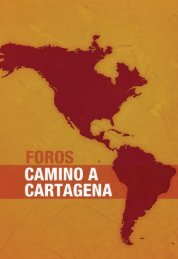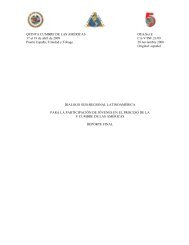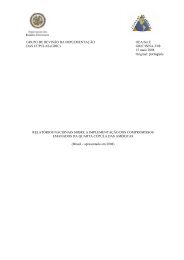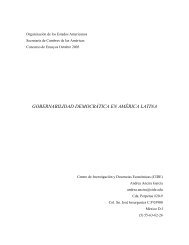The Road to Hemispheric Cooperation: Beyond the Cartagena
The Road to Hemispheric Cooperation: Beyond the Cartagena
The Road to Hemispheric Cooperation: Beyond the Cartagena
You also want an ePaper? Increase the reach of your titles
YUMPU automatically turns print PDFs into web optimized ePapers that Google loves.
12 Sadly this program soon collapsed, as <strong>the</strong> U.S. government<br />
failed <strong>to</strong> adequately fund it, and <strong>the</strong> three American scientists<br />
lost interest and began pursuing o<strong>the</strong>r opportunities.<br />
13 British Petroleum, BP Statistical Review of World Energy, June<br />
2012, p. 6. Available at http://bp.com/statisticalreview.<br />
14 José Miguel Insulza, “Energy and Development in South America,”<br />
in C. Arnson et al. (eds.), Energy and Development in South<br />
America: Conflict and <strong>Cooperation</strong> (Washing<strong>to</strong>n, D.C.: Woodrow<br />
Wilson International Center for Scholars, 2008), p. 9.<br />
15 Lila Barrera-Hernández, “South American Energy Network Integration:<br />
Mission Possible?” in M. M. Roogenkamp, et al. (eds.),<br />
Energy Networks and <strong>the</strong> Law: Innovative Solutions in Changing<br />
Markets (Oxford: Oxford University Press, 2012), p. 61.<br />
Natural gas’s reserves-<strong>to</strong>-production ratio exceeds 130 years in<br />
Bolivia, Ecuador, Peru, and Venezuela.<br />
16 United States Energy Information Agency, Brazil Country Analysis<br />
Brief, February 28, 2012. Available at http://www.eia.gov/<br />
emeu/cabs/Brazil/pdf.pdf. By way of comparison, renewable energy<br />
sources, including solar, wind, geo<strong>the</strong>rmal and biomass, as<br />
well as hydropower, generated only 13 percent of <strong>the</strong> electricity<br />
in <strong>the</strong> United States in 2011, while renewable sources contribute<br />
<strong>to</strong> approximately 8 percent of <strong>to</strong>tal energy consumption. One<br />
reason for Brazil’s high reliance on renewable energy resources<br />
is that almost <strong>the</strong> entire passenger vehicle fleet is now equipped<br />
with flex fuel engines that allow Brazilian drivers <strong>to</strong> run <strong>the</strong>ir cars<br />
exclusively on ethanol.<br />
17 M. Wolf, “Prepare for <strong>the</strong> Golden Age of Gas,” Financial Times,<br />
p. 9, February 22, 2012.<br />
18 Centre for International Governance Innovation (CIGI), Blueprint<br />
for a Sustainable Energy Partnership for <strong>the</strong> Americas (Waterloo,<br />
Ontario: CIGI, 2009), p. 9. Available at http://www.cigionline.org.<br />
19 At <strong>the</strong> U.N. Conference on Climate Change (COP 17) in Durban,<br />
South Africa in December 2011, some 35 industrialized countries<br />
agreed <strong>to</strong> extend <strong>the</strong>ir Kyo<strong>to</strong> Pro<strong>to</strong>col mandates (and, as<br />
a consequence, <strong>the</strong>ir participation in <strong>the</strong> CDM) until such time<br />
as a new climate change agreement is concluded by all U.N.<br />
member states. <strong>The</strong> deadline for achieving such an agreement,<br />
which will include <strong>the</strong> United States and all major developing<br />
countries committing <strong>to</strong> legally binding reductions in greenhouse<br />
gas emissions, is 2015.<br />
20 Research conducted by two Stanford University law professors<br />
in 2008 found that a large fraction of <strong>the</strong> credits generated under<br />
<strong>the</strong> CDM did not represent genuine reductions in greenhouse<br />
gas emissions, as many projects that “reduce” emissions would<br />
have been built anyway and at a far lower cost. Even worse, <strong>the</strong><br />
CDM creates perverse incentives for developing countries <strong>to</strong> increase<br />
carbon emissions as a way of generating CDM credits<br />
that can <strong>the</strong>n be offered <strong>to</strong> developed nations desperate <strong>to</strong> find<br />
offsets for <strong>the</strong>ir own pollution-inducing activities. See Michael<br />
Wara and David Vic<strong>to</strong>r, A Realistic Policy on International Carbon<br />
Offsets, Program on Energy and Sustainable Development<br />
Working Paper # 74, Freeman Spogli Institute for International<br />
Studies (Stanford University: April 2008). Available at http://fsi.<br />
stanford.edu/publications/a_realistic_policy_on_international_<br />
carbon_offsets/.<br />
21 CIGI, Blueprint for a Sustainable Energy Partnership for <strong>the</strong><br />
Americas. Interestingly, because Brazil’s emissions primarily<br />
come from <strong>the</strong> burning of tropical rain forests, this practice<br />
does not contribute <strong>to</strong> new global greenhouse emissions per<br />
se, as live trees naturally remove carbon from <strong>the</strong> air and, when<br />
burned, are simply releasing back in<strong>to</strong> <strong>the</strong> atmosphere what<br />
<strong>the</strong>y initially <strong>to</strong>ok out. So <strong>the</strong>re is no net gain or loss. See Bur<strong>to</strong>n<br />
Richter, <strong>Beyond</strong> Smoke and Mirrors: Climate Change and Energy<br />
in <strong>the</strong> 21st Century (New York: Cambridge University Press,<br />
2010), pp. 68-9. “Since plants get <strong>the</strong> carbon for <strong>the</strong>ir growth<br />
from <strong>the</strong> carbon dioxide in <strong>the</strong> atmosphere and release it on<br />
burning, <strong>the</strong>y do not give any net increase in greenhouse gas<br />
as long as <strong>the</strong>y are grown without fertilizers and o<strong>the</strong>r modern<br />
agriculture technology.” <strong>The</strong> real problem, of course, is <strong>the</strong> soot<br />
released by <strong>the</strong> mass burning of trees, which creates havoc in<br />
<strong>the</strong> atmosphere in terms of trapping or keeping out solar rays<br />
as well as <strong>the</strong> previously mentioned loss of a natural means<br />
for sequestering new carbon dioxide emissions from <strong>the</strong> heavy<br />
global use of fossil fuels.<br />
22 REDD is an effort <strong>to</strong> create a financial value for <strong>the</strong> carbon<br />
s<strong>to</strong>red in forests, offering incentives for developing countries <strong>to</strong><br />
reduce emissions from forested lands and invest in low-carbon<br />
paths <strong>to</strong> sustainable development. REDD-plus includes <strong>the</strong><br />
role of conservation, sustainable management of forests, and<br />
enhancement of forest carbon s<strong>to</strong>cks as a way <strong>to</strong> potentially<br />
generate financial flows from <strong>the</strong> developed world <strong>to</strong> developing<br />
countries under any new multilateral climate agreement <strong>to</strong><br />
replace <strong>the</strong> Kyo<strong>to</strong> Pro<strong>to</strong>col with a new multilateral agreement<br />
no later than 2015. At <strong>the</strong> December 2011 U.N. Climate Change<br />
conference in Durban, South Africa, standards were issued for<br />
financing REDD-plus projects (including <strong>the</strong> use of market and<br />
non-market sources).<br />
23 Anthony T. Bryan, “Trinidad and Tobago,” in Sidney Weintraub<br />
(ed.), Energy <strong>Cooperation</strong> in <strong>the</strong> Western Hemisphere: Benefits<br />
and Impediments (Washing<strong>to</strong>n, D.C.: Center for Strategic and<br />
International Studies, 2007), p. 381. Approximately 93 percent<br />
of <strong>the</strong> Caribbean’s energy consumption is fossil fuel based,<br />
while only 4 percent comes from renewable energy.<br />
<strong>The</strong> <strong>Road</strong> <strong>to</strong> <strong>Hemispheric</strong> <strong>Cooperation</strong>: <strong>Beyond</strong> <strong>the</strong> <strong>Cartagena</strong> Summit of <strong>the</strong> Americas<br />
<strong>The</strong> Brookings Institution ❘ Latin America Initiative<br />
56








